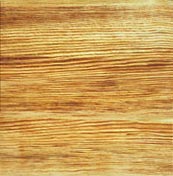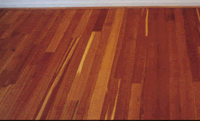
The Wood
Common Uses
| Bridge construction • Utility Poles • Marine pilings • Mine timbers • Office furniture Kitchen cabinets • Living-room suites • Sub-flooring Cabinetmaking • Flooring Furniture • Heavy construction • Fence posts |
|
Category |
Green |
Dry |
Unit |
|
Bending strength |
10260 |
14725 |
psi |
|
Crushing strength (Perp.) |
700 |
1210 |
psi |
|
Crushing strength |
4850 |
8540 |
psi |
|
Static bending (FSPL) |
6090 |
9850 |
psi |
|
Impact strength |
40 |
36 |
Inches |
|
Stiffness |
1880 |
2240 |
1000 psi |
|
Work to maximum load |
11 |
17 |
in-lbs/in3 |
|
Hardness |
1120 |
lbs |
|
|
Shearing strength |
2090 |
psi |
|
|
Toughness |
251 |
in-lbs |
|
|
Specific Gravity |
0.78 |
||
|
Weight |
48 |
lbs/cu.ft. |
|
|
Density (Air-dry) |
45 |
lbs/cu.ft. |
|
|
Radial shrinkage (G->OD) |
6 |
% |
|
|
Tangential shrinkage (G->OD) |
8 |
% |
|
|
Volumetric shrinkage (G->OD) |
13 |
% |
Tree Data
The
tree is reported to attain a height of about 100 feet (30 m), with a trunk
diameter of 40 inches (75 to 100 cm), sometimes larger. It develops boles
with a moderate taper, are about 70 feet (21 M) long.
Sapwood Color
The sapwood is easily distinguishable, and is lighter in
color than the heartwood.
Heartwood Color
The color of the heartwood is generally golden brown to red
brown. Resin canals are reported to be numerous.
Grain
The grain is usually straight.
Texture
The texture is described as somewhat coarse.
Luster
The wood has medium luster.
Odor
The wood imparts a strong resinous odor.
Ease of Drying
The timber is reported to air-season rather slowly, with
very little degradation.
Drying Defects
Timber in thicker sizes may split, and low-density plantation
wood may warp slightly during drying.
Kiln Schedules
T10 – D4S (4/4); T8 – D3S (8/4) US
T/R Ratio
1.33
This indicator is more meaningful if it is used together
with other drying information and actual shrinkage data in the tangential
and radial directions. (Refer to the Numerical Values
Window).
Natural Durability
Performance against attack by decay fungi is reported to
be determined by the amount of resin in the wood. Heartwood resistance
is rated as generally moderate, and could last up to 15 years in contact
with the ground without any chemical protection. The sapwood is prone
to blue-stain.
Resistance to Impregnation
The heartwood is reported to have moderate response to preservative
penetration, but sapwood is reported to be highly permeable.
Abnormal Wood Tissue
Compression wood is reported to be common.
Cutting Resistance
The wood has low resistance to sawing although cutters may
be gummed up due to the high resin content.
Planing
Planing properties are reported to be generally good.
Turning
The wood turns well, but resin may gum up cutters.
Molding
Molding characteristics are reported to be generally good.
Boring
The material is reported to respond well to boring.
Routing & Recessing
Routing qualities are reported to be generally good.
Mortising
The wood is reported to respond well to ordinary tools in
mortising.
Carving
The material has good carving properties.
Gluing
The timber is reported to have satisfactory gluing properties.
Nailing
The wood is reported to take nails well.
Screwing
Screwing properties are rated as good.
Sanding
Sanding qualities are reported to be generally good.
Response to Hand Tools
The wood responds well to hand tools.
Strength Properties
This species has high bending strength in the air-dry condition
(about 12 percent moisture content). Maximum crushing strength, or compression
parallel to grain in the air-dry condition, is also in the high range.
It is fairly hard, resisting wear, denting, and marring fairly well. The
wood is heavy and dense.
 |
 |
| Home | Products | Company | |
| Caswell
Forest Products LLC 8596 Fort Valley Road Fort Valley, VA 22652 © 2006 Caswell Forest Products |
|